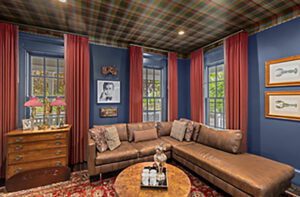Into the Wood
October 15, 2013
Text by Charles Monagan
“I have a confession to make: I’m a wood nut.”
As he divulges this not-very-well-kept secret, Peter Petrochko is standing just outside the entrance to his backyard work shed in Quaker Farms. It’s a comfortable place for him, a place where he is literally surrounded by the wood he loves. Inside the shed, leaning against the walls, stacked on the floor, and threatening to tumble right out the door, are dozens of different species of milled wood—cherry, walnut, and maple, to be sure, but also butternut, koa, and gonçalo alves. Outside, in rougher form and spilling out in every direction like an unruly herd, are what Petrochko refers to as “chunks” of various trees—catalpa here, copper beech there, a huge, knotty black cherry burl in between. From all this raw wood, Petrochko produces pieces of exquisite craftsmanship and beauty—a straight-out act of alchemy he’s been perfecting for some forty years.
Petrochko’s sculptural output involves both strength and precision, what with all the wood hauling and splitting, band sawing, laminating, hand carving, and disc sanding. Look at his work and you’ll see he’s a purist who prefers natural, irregular shapes and forgoes stains and dyes. His pieces may find some practical use in a buyer’s home, but more often they stand as objects to wonder at and admire.
Petrochko grew up in Bridgeport, where his father—it should come as no surprise—had a firewood business. Next door to the Petrochko home was a large property where Petrochko spent many hours daydreaming as a young boy. “When I was six or seven, I used to go over there and just observe,” he recalls. “There were woods and a brook—acres, it seemed like. Ever since, I’ve felt close to the natural world.”
Petrochko went to the University of Cincinnati, expecting to become an architect. He vividly recalls an assignment given during his freshman year. Each student was handed a six-inch cube of redwood and told to “make a composition.”
“I spent thirty hours carving through it like a giant carpenter ant,” he remembers, “and then another thirty hours sanding it.” And somewhere in those sixty hours a passion was born. Gradually sensing that architecture would not be in his future, he left Cincinnati and enrolled at the Silvermine College of Art in Norwalk to study fine arts. Again and again, he returned to wood, and during the crafts boom of the 1970s he found himself selling his carving boards, boxes, and canisters. He made a metronome for one client, a king-size bed for another. “I made whatever it was that someone wanted,” he says. And along the way, he began making a living. By 1980, he was able to drop the landscaping business that had paid the bills, and focus on producing fine wooden bowls, laminated vessels, furniture, and sculpture. Eventually, he was invited to prestigious national crafts shows, and his work was collected everywhere from the Museum of Fine Arts in Boston to the White House.
Back by his shed, Petrochko casts his eye over the wood spread out all around him and begins to tell their stories. The chunk of oak on the outdoor worktable is one of four given to him by a couple from Wilmette, Illinois, who met him at a crafts show at Northwestern University and want proper commemoration of a big oak that once graced their yard. Petrochko will make four laminated vessels from what they gave him. He has studied the oak, chalked off where he wants to go with it, cut a series of trenches with a chainsaw, and now is going to work on it with a gouge and mallet. At length, he will trim off the excess wood, then take it to his basement workshop in the main house for refining, polishing, and laminating.
Moving on, he notes that the sugar maple logs by the door came from the nearby Quaker Farms Volunteer Fire Department, which he happened to be passing one day as they were taking down the tree. He asked if he could bring some of the logs home and now, as a thank-you, the QFVFD will get a sugar maple bowl to auction off at its next fund-raiser.
The stories continue. The return of the American chestnut, the plague of the emerald ash borer, the overpowering fragrance of the imbuia, when to harvest a spalted maple—it’s all part of the artist’s database, the raw material he considers as he works through his colossal inventory, creating, one-by-one, objects of lasting beauty. •
EDITOR’S NOTE: To see more of Peter Petrochko’s work, visit peterpetrochko.com
Share
![NEH-Logo_Black[1] NEH-Logo_Black[1]](https://b2915716.smushcdn.com/2915716/wp-content/uploads/2022/08/NEH-Logo_Black1-300x162.jpg?lossy=1&strip=1&webp=1)













You must be logged in to post a comment.